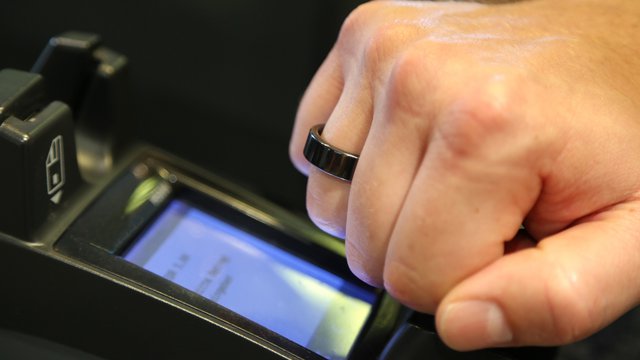Nov. 30, 2018 | by David Jones

Infineon developed several wearable payment options including a smart ring.
As the competition for digital wallets and contactless payments has accelerated in recent years, much of the innovation has centered around the mobile phone, but an increasingly important, yet often overlooked, category is the wearables category.
Wearables have largely been dominated by smart watches, led by Apple, which has dominated a brutally competitive space that includes iconic watch maker Timex as well as fitness oriented products from Fitbit, Garmin and other manufacturers.
Apple in October announced plans to add support for student identifications built into its digital wallet, allowing students at Duke University, University of Alabama and other campus to use their watch and iPhones for laundry, books and other school related payments.
Timex just this week announced an agreement with Beijing-based Huami to develop smartwatch technology that includes digital payments. Meanwhile Google in September announced an update to its wearable operating platform that it renamed Wear OS, which provides for payment and other technology on smartwatches and other wearable devices.
Data from research firm IDC shows consumer interest in the general wearables space has begin to slow as demand is growing for more sophisticated applications to be included in the category. Global shipments of wearables rose only 1.2 percent during the first quarter to about 25 million, far down from the 18 percent year-over-year growth in the same period in 2017, according to a report released in June
A growing number of players are looking to expand the category beyond watches and embed smart chip technology into a wider range of devices.
Stay fit
Inamo, a startup based in Australia, launched in early November a pilot program to test watches, key chains and other wearables in the U.S. Users can slip a passive micro-card into the Inamo curl, which is waterproof durable silicone and slips into most watches and fitness bands, according to company officials.
Users can load up the Inamo prepaid debit card using most banks and make payments anywhere that accepts contactless payments including locations that accept Google or Apple Pay. Locations with the contactless MasterCard PayPass and Square symbols can also accept Inamo Pay.
"Inamo wearable are designed for people of all ages that are on the go, where standard chip cards and traditional magnetic stripe cards just slow the whole payment process down," Fiona Whitaker, head of payments and business at Inamo, told Mobile Payments Today in an email.
Most transactions are geared toward coffee, gasoline, fast food or trips to a local pharmacy she said. However users wanting to make a purchase greater than $100 can just tap their wearable at the point of sale and then enter a four-digit PIN code, she added.
Bank rollout
After completing successful internal tests in 2017, Amsterdam-based bank ABN Amro teamed up with Mastercard and Digiseq in January 2018 and launched a four-month pilot program where 500 customers signed up to test a range of contactless payment using wearables, including rings, bracelets and key rings.
The wearables had embedded NFC technology that met the same security standards as regular plastic cards and users responded with a great deal of enthusiasm to the technology, according to ABN Amro spokesman Geer van der Varst.
He said almost 80 percent of the user group preferred paying with the wearable devices rather than using the standard card and the average user used the chip payment about six times a week for transactions under 25 euros, as price limits were placed on individual transactions.
"The feature that was most asked for was to make payments possible over EUR 25," he said in an email.
The bank is working on expanding those limits and is looking to open the wearable contactless payment system to all customers in 2019.
Wireless spectators
On Nov. 25th, Infineon Technologies announced a program called the Secora Pay W for Smart Payment Accessories, which offers wearable contactless payment technology, with ENV enabled bracelets, watches, key chains and rings.
Wirecard along with exceet Card Group AG and German online bank Comdirect recently used the technology during the 2018 German Beach Volleyball Championships in Timmendorfer Strand in from Aug. 31-Sept. 2, where up to 5,000 fans were given wristbands embedded with contactless tap and go technology that allowed them to pay for items during the event.
"The convenience of a wearable for small purchase transactions makes a case for this being the most typical use," said an Infineon spokesman. "This is particularly true if the payment wearable is linked to prepaid and debit card accounts with restricted funds availability."
Topics: Contactless / NFC, EMV, Mobile/Digital Wallet, Region: Americas, Region: APAC, Region: EMEA
Companies: Apple, Wirecard, Timex, Garmin
David Jones
David Jones is a veteran business and technology journalist, with three decades of experience writing about business travel, real estate and technology.
Since 2015 he covered a range of technology stories for the ECT News Network, which includes the E-Commerce Times, TechNewsWorld, LinuxInsider and CRM Buyer, writing about cybersecurity, artificial intelligence, machine learning, open source computing and privacy issues among others,. He recently covered FinTech issues for PYMNTS.com.
He worked as a staff writer for Bloomberg Business News and an online reporter for Crain’s New York Business. He has written for numerous media organizations, including Reuters, The New York Times, The Real Deal, Continental, City Limits and The Nation.
He was previously awarded the George Washington Williams Fellowship for Journalists of Color by the Independent Press Association.
Sponsored Links:

